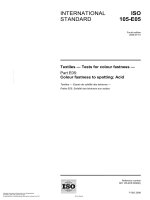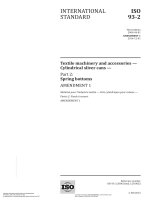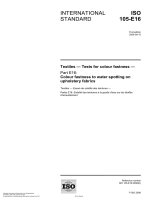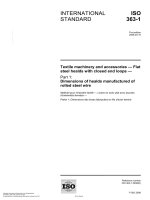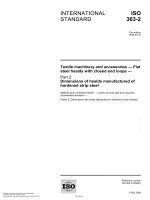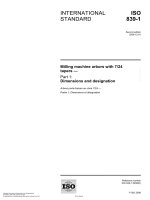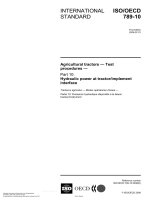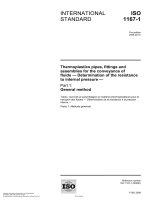Tiêu chuẩn iso 15531 43 2006
Bạn đang xem bản rút gọn của tài liệu. Xem và tải ngay bản đầy đủ của tài liệu tại đây (288.2 KB, 32 trang )
INTERNATIONAL
STANDARD
ISO
15531-43
First edition
2006-08-15
Industrial automation systems and
integration — Industrial manufacturing
management data —
Part 43:
Manufacturing flow management data:
Data model for flow monitoring and
manufacturing data exchange
Systèmes d'automatisation industrielle et intégration — Données de
gestion de fabrication industrielle —
--`,,```,,,,````-`-`,,`,,`,`,,`---
Partie 43: Données de gestion des flux de fabrication: Modèle de
données pour suivi des flux et échange des données de fabrication
Reference number
ISO 15531-43:2006(E)
Copyright International Organization for Standardization
Provided by IHS under license with ISO
No reproduction or networking permitted without license from IHS
© ISO 2006
Not for Resale
ISO 15531-43:2006(E)
PDF disclaimer
This PDF file may contain embedded typefaces. In accordance with Adobe's licensing policy, this file may be printed or viewed but
shall not be edited unless the typefaces which are embedded are licensed to and installed on the computer performing the editing. In
downloading this file, parties accept therein the responsibility of not infringing Adobe's licensing policy. The ISO Central Secretariat
accepts no liability in this area.
Adobe is a trademark of Adobe Systems Incorporated.
--`,,```,,,,````-`-`,,`,,`,`,,`---
Details of the software products used to create this PDF file can be found in the General Info relative to the file; the PDF-creation
parameters were optimized for printing. Every care has been taken to ensure that the file is suitable for use by ISO member bodies. In
the unlikely event that a problem relating to it is found, please inform the Central Secretariat at the address given below.
© ISO 2006
All rights reserved. Unless otherwise specified, no part of this publication may be reproduced or utilized in any form or by any means,
electronic or mechanical, including photocopying and microfilm, without permission in writing from either ISO at the address below or
ISO's member body in the country of the requester.
ISO copyright office
Case postale 56 • CH-1211 Geneva 20
Tel. + 41 22 749 01 11
Fax + 41 22 749 09 47
Web www.iso.org
Published in Switzerland
ii
Copyright International Organization for Standardization
Provided by IHS under license with ISO
No reproduction or networking permitted without license from IHS
© ISO 2006 – All rights reserved
Not for Resale
ISO 15531-43 : 2006 (E)
--`,,```,,,,````-`-`,,`,,`,`,,`---
Contents
1
Scope ............................................................................................................................................... 1
2
Normative references ...................................................................................................................... 1
3
Terms, definitions, and abbreviations ............................................................................................. 2
3.1
Terms and definitions.............................................................................................................. 2
3.2
Abbreviations .......................................................................................................................... 7
4
General purpose and scope of ISO 15531 ....................................................................................... 7
5
Manufacturing flow management data............................................................................................ 8
5.1
Management of manufacturing flows...................................................................................... 8
5.2
Fundamental concepts and assumptions................................................................................ 10
5.3
Manufacturing flow management data schema definition .................................................... 12
5.4
manufacturing flow management data type definitions ........................................................ 13
5.4.1
type_of_flow ................................................................................................................. 13
5.4.2
type_of_material_flow .................................................................................................. 13
5.5
Manufacturing flow management data subtype constraint definitions.................................. 14
5.5.1
material_information ..................................................................................................... 14
5.5.2
rawmat_component ....................................................................................................... 14
5.6
Manufacturing flow management dataentity definitions....................................................... 14
5.6.1
process ........................................................................................................................... 14
5.6.2
flow................................................................................................................................ 15
5.6.3
Process flow assignment ............................................................................................... 16
5.6.4
process_property_value................................................................................................. 16
5.6.5
flow_property_value ..................................................................................................... 16
5.6.6
material_flow................................................................................................................. 17
5.6.7
information_flow........................................................................................................... 17
5.6.8
raw_material.................................................................................................................. 18
5.6.9
component ..................................................................................................................... 18
Annex A (normative) Use of ASN.1 Identifiers in SC4 standards........................................................ 19
Annex B (informative) EXPRESS listing ............................................................................................. 20
Annex C (informative) EXPRESS-G diagram ...................................................................................... 23
Bibliography.......................................................................................................................................... 24
Index...................................................................................................................................................... 25
© ISO 2006 All rights reserved
Copyright International Organization for Standardization
Provided by IHS under license with ISO
No reproduction or networking permitted without license from IHS
iii
Not for Resale
ISO 15531-43 : 2006 (E)
Figures
Figure 1 — Multiple manufacturing processes in a factory .................................................................... 9
Figure 2 — Relationships between two manufacturing processes in a factory..................................... 10
Figure 3 — Process that supports the flows between manufacturing processes A and B ..................... 11
Figure 4 — Example of flow separation ............................................................................................... 11
Figure C.1 — Manufacturing_flow_management_data_schema .......................................................... 23
© ISO 2006 All rights reserved
iv
--`,,```,,,,````-`-`,,`,,`,`,,`---
Copyright International Organization for Standardization
Provided by IHS under license with ISO
No reproduction or networking permitted without license from IHS
Not for Resale
--`,,```,,,,````-`-`,,`,,`,`,,`---
ISO 15531-43 : 2006 (E)
Foreword
ISO (the International Organization for Standardization) is a worldwide federation of national
standards bodies (ISO member bodies). The work of preparing International Standards is normally
carried out through ISO technical committees. Each member body interested in a subject for which a
technical committee has been established has the right to be represented on that committee.
International organizations, governmental and non-governmental, in liaison with ISO, also take part in
the work. ISO collaborates closely with the International Electrotechnical Commission (IEC) on all
matters of electrotechnical standardization.
International Standards are drafted in accordance with the rules given in the ISO/IEC Directives,
Part 2.
The main task of technical committees is to prepare International Standards. Draft International
Standards adopted by the technical committees are circulated to the member bodies for voting.
Publication as an International Standard requires approval by at least 75 % of the member bodies
casting a vote.
Attention is drawn to the possibility that some of the elements of this document may be the subject of
patent rights. ISO shall not be held responsible for identifying any or all such patent rights.
ISO 15531-43 was prepared by Technical Committee ISO TC184/SC4, Industrial automation systems
and integration, Subcommittee SC4, Industrial data.
A complete list of parts of ISO 15531 is available from the Internet:
/>
© ISO 2006 All rights reserved
Copyright International Organization for Standardization
Provided by IHS under license with ISO
No reproduction or networking permitted without license from IHS
v
Not for Resale
ISO 15531-43 : 2006 (E)
Introduction
A manufacturing management system manages the flow of information and materials through the
whole production chain, from suppliers, through to manufacturers, assemblers, distributors, and
sometimes customers.
The relations among those partners may be identified and structured in an electronic form with a view
to facilitating electronic exchanges. Information handled during these exchanges is identified,
modelled and represented in such a way that may be shared by a maximum of partners through the
usage of standards for product and manufacturing data modelling.
The production planning functions within the supplier plants are assumed to have strong relationships
with the master production scheduling functions of the main plant, which shares information with
them, on the likely pattern of the future demands to allow suppliers to plan in turn their production. On
a day-to-day basis, the operational planning system of the main plant sends orders to the suppliers to
ensure the availability of components, sub-assemblies and others, such as resources needed for its
manufacturing and assembly process.
ISO 15531 addresses the type of information described above. It is does not standardise the model of
the manufacturing process. The aim of ISO 15531 is to provide a standardised data model for
representing manufacturing management data. Its purpose is to facilitate the integration between the
numerous industrial applications by means of common, standardised software that is able to represent
these three sets of data.
ISO 15531 is organised as a series of parts, each published separately. The parts of ISO 15531 fall into
the following series: production data for external exchange, manufacturing resources usage
management data, time model management and manufacturing flow management data.
This part of ISO 15531 addresses the representation of data related to manufacturing flow and process
management, through the development of a data model of the manufacturing flows and processes.
Particular attention has been paid in the development of this part of ISO 15531 to the relation with the
other standards developed in ISO TC184/SC4, such as ISO 10303, ISO 13584, ISO 15926. In addition
to the fact that this part of ISO 15531 is developed using EXPRESS language (see ISO 10303-11:
2004) Edition 2, it makes extensive use of several constructs of ISO 10303-41, and references
ISO 13584 dictionaries.
© ISO 2006 All rights reserved
vi
Copyright International Organization for Standardization
Provided by IHS under license with ISO
No reproduction or networking permitted without license from IHS
Not for Resale
--`,,```,,,,````-`-`,,`,,`,`,,`---
The information generated about the manufacturing process of an industrial product is very important
for the life cycle of this product, notably in a context of sustainable development. Manufacturing may
be defined as the transformation of raw material or semi-finished components leading to goods
production. Manufacturing management is the function of directing or regulating the flows of goods
through the entire production cycle from requisitioning of raw materials to the delivery of the finished
product, including the impact on resources management.
INTERNATIONAL STANDARD
ISO 15531-43 : 2006 (E)
Industrial automation systems and integration ⎯
Industrial manufacturing management data ⎯
Part 43:
Manufacturing flow management data: Data model for flow
monitoring and manufacturing data exchange
1
Scope
This part of ISO 15531 provides a data model for flow management, and a related set of building
blocks, from which are specified standardized data models and representations for the planning,
scheduling, controlling and monitoring of material and informational flows. This is in contrast with
ISO 15531-42, which provides a time model only.
Consequently this part of ISO 15531 provides a representation of data related to flow control and
management in manufacturing, through the development of a conceptual flow model.
The following are within the scope of this part of ISO 15531:
⎯ representation of data related to the management and control of manufacturing flows.
NOTE – This information is usually provided within the main plant, and exchanged among the different
machine tools, or production cells.
The following are outside the scope of this part of ISO 15531:
⎯ modelling of information related to the external exchanges;
⎯ modelling of information related to the resource usage made during the manufacturing processes;
⎯ modelling of the information related to the representation of the time.
2
Normative references
The following referenced documents are indispensable for the application of this document. For dated
references, only the edition cited applies. For undated references, the latest edition of the referenced
document (including any amendments) applies.
ISO/IEC 8824-1, Information technology – Abstract Syntax Notation One (ASN.1) - Part 1:
Specification of basic notation
ISO 10303-1, Industrial automation systems and integration – Product data representation and
exchange - Part 1: Overview and fundamental principles
ISO 10303-11: 2004, Industrial automation systems and integration – Product data representation
and exchange – Part 11: Description methods: The EXPRESS language reference manual
©ISO 2006 All rights reserved
1
--`,,```,,,,````-`-`,,`,,`,`,,`---
Copyright International Organization for Standardization
Provided by IHS under license with ISO
No reproduction or networking permitted without license from IHS
Not for Resale
ISO 15531-43 : 2006 (E)
ISO 10303-41, Industrial automation systems and integration – Product data representation and
exchange – Part 41: Integrated generic resources: Fundamentals of product description and support
ISO 10303-49, Industrial automation systems and integration – Product data representation and
exchange – Part 49: Integrated generic resources: Process structures and properties
ISO 13584-1, Industrial automation systems and integration – Parts library – Part 1: Overview and
fundamental principles
ISO 13584-24, Industrial automation systems and integration – Parts library – Part 24: Logical
resource: Logical model of supplier library
ISO 15531-1, Industrial automation systems and integration – Industrial manufacturing management
data – Part 1:General overview
ISO 15531-32, Industrial automation systems and integration – Industrial manufacturing
management data: Resources usage management – Part 32: Conceptual model for resources usage
management data
ISO 15531-42, Industrial automation systems and integration – Industrial manufacturing management
data – Part 42 : Time model
IEC 62264-1 : 2003, Enterprise-control system integration ─ Part 1 : Models and terminology
3
3.1
Terms, definitions, and abbreviations
Terms and definitions
For the purposes of this document, the following definitions apply:
3.1.1
capability
quality of being able to perform a given activity
NOTE The capability is defined by a group of characteristics that describes functional aspects of manufacturing
resources or system.
[ISO 15531-1]
3.1.2
capacity
capability of a system, sub-system or resource to perform its expected function from a quantitative
point of view
EXAMPLE The capacity of a system or a resource to produce a given quantity of output in a particular time
period.
NOTE For a given system or resource the distinction between capacity available and capacity requested may be
© ISO 2006 All rights reserved
2
Copyright International Organization for Standardization
Provided by IHS under license with ISO
No reproduction or networking permitted without license from IHS
Not for Resale
--`,,```,,,,````-`-`,,`,,`,`,,`---
ISO 15531-31: 2004, Industrial automation systems and integration – Industrial manufacturing
management data – Part 31: Resource information model
ISO 15531-43 : 2006 (E)
useful.
[ISO 15531-1]
3.1.3
carrying process
transportation process
process that supports flows between other processes
NOTE The other processes may be manufacturing processes and/or other carrying processes. A carrying process
is a specialisation of process, it may also be considered as a specialisation of manufacturing process.
Nevertheless in the context of flow management a clear distinction shall be made between processes that support
directly the manufacturing and process that are more logistic and facilities-oriented.
3.1.4
data
representation of information in a formal manner suitable for communication, interpretation, or
processing by human beings or computers
[ISO 10303-1]
3.1.5
data exchange
storing, accessing, transferring, and archiving of data
--`,,```,,,,````-`-`,,`,,`,`,,`---
[ISO 10303-1]
3.1.6
device
any identified physical equipment, system or subsystem that does not belong to software, data set or
human resource class
NOTE A device may nevertheless include software.
[ISO 15531-1]
3.1.7
discrete manufacturing
production of discrete items
EXAMPLE Cars, appliances or computer.
[ISO 15531-1]
3.1.8
division process
carrying process that divides flows into more flows
3.1.9
entity
class of information defined by common properties
[ISO 10303-11]
© ISO 2006 All rights reserved
Copyright International Organization for Standardization
Provided by IHS under license with ISO
No reproduction or networking permitted without license from IHS
3
Not for Resale
ISO 15531-43 : 2006 (E)
3.1.10
enterprise entity
any concrete or abstract thing in the universe of discourse of an enterprise
NOTE The concept provided here belongs to the broader concept of entity as defined in ISO 15704 [2]. The
concept of entity as defined in those standards has been restricted here to avoid inconsistency with the term of
entity as defined in ISO 10303-11. Then excepted in the definition of universe of discourse the term entity
applies in ISO 15531 with the definition provided by ISO 10303-11.
[ISO 15531-1]
3.1.11
environment
part of the universe of discourse that does not belong to the system itself
EXAMPLE Inputs and outputs of the systems, such as raw material, final products etc., belong to the
environment of the system as well as constraints that apply to it or time
[ISO 15531-42]
[ISO 15531-1]
3.1.13
flow control
specific production control system that is based primarily on setting production rates and feeding work
into production to meet these planned rates, then monitoring and controlling production
NOTE That includes the act of checking and driving the flow according to a given purpose. The term may also
apply to the function or service. Definition adapted from APICS dictionary [5].
[ISO 15531-1]
3.1.14
flow model
representation or description of manufacturing-related flows describing only the aspects relevant for
its purpose
[ISO 15531-1]
3.1.15
information
facts, concepts, or instructions
[ISO 10303-1]
© ISO 2006 All rights reserved
4
Copyright International Organization for Standardization
Provided by IHS under license with ISO
No reproduction or networking permitted without license from IHS
Not for Resale
--`,,```,,,,````-`-`,,`,,`,`,,`---
3.1.12
flow
motion of a set of physical or informational objects in space and time
ISO 15531-43 : 2006 (E)
3.1.16
junction process
carrying process that enables the grouping of several flows into one or more other flows
3.1.17
manufacturing
function or act of converting or transforming material from raw material or semi-finished state to a
state of further completion
NOTE Definition adapted from APICS dictionary [5].
[ISO 15531-1]
3.1.18
manufacturing management
function or act of directing or regulating the flows of goods through the entire production cycle from
requisitioning of raw materials to the delivery of the finished product, including the impact on
resources management
[ISO 15531-1]
NOTE Manufacturing processes may be arranged in process layout, product layout, cellular layout or fixed
position layout. Manufacturing processes may be planned to support make-to-stock, make-to-order, assemble-toorder, etc., based on strategic use and placements of inventories.
[ISO 15531-1]
3.1.20
model
representation or description of an entity or a system, describing only the aspects considered to be
relevant for its purpose
NOTE Entity is not used here with the meaning provided by ISO 10303-11 but with the sense usually given in
ISO 15704 [2]
[ISO 15531-1]
3.1.21
operation
job or task consisting of one or more work elements, usually done essentially in one location
NOTE Definition from APICS dictionary [5].
3.1.22
planning
analysis and design of the sequence of processes, of the resource requirements and flow management
constraints needed to achieve a given operation
© ISO 2006 All rights reserved
Copyright International Organization for Standardization
Provided by IHS under license with ISO
No reproduction or networking permitted without license from IHS
5
Not for Resale
--`,,```,,,,````-`-`,,`,,`,`,,`---
3.1.19
manufacturing process
structured set of activities or operations performed upon material to convert it from the raw material or
a semifinished state to a state of further completion
ISO 15531-43 : 2006 (E)
[ISO 10303-1]
3.1.23
process
structured set of activities involving various enterprise entities, that is designed and organised for a
given purpose
NOTE The definition provided here is very close to that given in ISO 10303-49. Nevertheless ISO 15531 needs
the notion of structured set of activities, without any predefined reference to the time or steps. In addition, from
the point of view of flow management, some empty processes may be needed for a synchronisation purpose
although they are not actually doing anything (ghost task).
[ISO 15531-1]
3.1.24
product
thing or substance produced by a natural or artificial process
[ISO 10303-1]
3.1.25
product data
representation of information about a product in a formal manner suitable for communication,
interpretation, or processing by human beings or by computers
[ISO 10303-1]
--`,,```,,,,````-`-`,,`,,`,`,,`---
3.1.26
resource
any device, tool and means, excepted raw material and final product components, at the disposal of the
enterprise to produce goods or services
NOTE 1 Resources as they are defined here include human resources considered as specific means with a given
capability and a given capacity. Those means are considered as being able to be involved in the manufacturing
process through assigned tasks. That does not include any modelling of an individual or common behaviour of
human resource excepted in their capability to perform a given task in the manufacturing process (e.g.:
transformation of raw material or component provision of logistic services). That means that human resources
are only considered, as the other, from the point of view of their functions, their capabilities and their status (e.g.:
idle, busy). That excludes any modelling or representation of any aspect of individual or common «social»
behaviour.
NOTE 2 This definition includes ISO 10303-49 definition.
[ISO 15531-1]
3.1.27
scheduling
act, function or result of planning occurrences of manufacturing activities
[ISO 15531-1]
© ISO 2006 All rights reserved
6
Copyright International Organization for Standardization
Provided by IHS under license with ISO
No reproduction or networking permitted without license from IHS
Not for Resale
ISO 15531-43 : 2006 (E)
3.1.28
unit of time
unit that is implicitly or explicitly a multiple of the internationally-defined second, to which a measure
of time in a time domain refers
NOTE 1 In other words, unit of time is the quantity of time chosen as a reference, in terms of which other
quantities of time may be expressed. The second is the unit of time defined in the SI system of units.
NOTE 2 The multiplication ratio may be either greater or smaller than one.
[ISO 15531-42]
3.1.29
universe of discourse
the collection of concrete or abstract things that belong to an area of the real world, selected according
to its interest for the system to be modelled and for its corresponding environment.
NOTE Definition adapted from ISO 19439 [3]
[ISO 15531-1]
3.2
Abbreviations
For the purposes of this part of ISO 15531, the following abbreviations applies:
4
MANDATE
MANufacturing management DATa Exchange
STEP
STandard for the Exchange of Product model data
General purpose and scope of ISO 15531
--`,,```,,,,````-`-`,,`,,`,`,,`---
ISO 15531, also known as MANDATE, specifies the characteristics for a representation of
manufacturing management information over the entire industrial process, with the necessary
mechanisms and definitions to enable manufacturing management data to be shared and exchanged
within the factory, with other plants or with companies.
Exchanges are made through different computer systems and environments associated with the
complete industrial process. ISO 15531 focuses on discrete manufacturing but is not limited to it.
Nevertheless, any extension to industrial processes which does not belong to discrete manufacturing is
always under consideration when it does not imply any contradiction or inconsistency with the initial
objective of ISO 15531.
The following are within the scope of ISO 15531:
⎯ the representation of production and resources information, including capability, capacity,
monitoring, maintenance constraints and control;
NOTE - Maintenance constraints and relevant maintenance management data are taken into account from the
© ISO 2006 All rights reserved
Copyright International Organization for Standardization
Provided by IHS under license with ISO
No reproduction or networking permitted without license from IHS
7
Not for Resale
ISO 15531-43 : 2006 (E)
point of view of their impact on the flow control.
⎯ the exchange and sharing of production information and resources information, including storing,
transferring, accessing and archiving.
The following are outside the scope of ISO 15531:
⎯ enterprise modelling;
NOTE - That means that tools, architecture and methodologies for the modelling of an enterprise as a whole are
not within the scope of ISO 15531.
⎯ product data (representation and exchange of product information);
⎯ component data (parts library: representation and exchange of computer-interpretable parts library
information);
⎯ cutting tools (electronic representation for exchange of cutting tool data);
⎯ technical maintenance information (technical information such as those included in devices repair,
operation and maintenance manuals).
5
5.1
Manufacturing flow management data
Management of manufacturing flows
This part of ISO 15531 addresses the modelling of data for the management of manufacturing flows as
well as flow control in a shop floor or factory. This manufacturing flow model is provided in the
context of various processes that run simultaneously and/or sequentially, providing one or more
products and/or components and involving numerous resources as indicated in Figure 1.
In this context one component may be the input of several processes, one process may provide
different components and/or product simultaneously or successively, different processes may make
use of the same resource successively.
EXAMPLE 1 In the Figure 1 the same component (or raw material) C2 is an input of processes A and F, as well
as component (or raw material) C3 for processes F and L.
EXAMPLE 2 In the Figure 1 process A provides components for both processes B and D ; process F provides
components for process C, K and G ; process L provides components for processes H and M, etc. that may occur
simultaneously or successively.
EXAMPLE 3 In the Figure 1 process E gets components from processes D and C and provides products (or
components) P2 and P3; process D provides, product (or component) P1 and a component for process E as well
as process N gets components from processes H and M to provide products (or components) P7 and P8. All
these operations may occur simultaneously or successively.
EXAMPLE 4 Processes B and C make, successively, use of the same resources, as well as processes G and H
with another resource.
This part of ISO 15531 provides a way to model the data needed to manage the multiple complex
© ISO 2006 All rights reserved
8
--`,,```,,,,````-`-`,,`,,`,`,,`---
Copyright International Organization for Standardization
Provided by IHS under license with ISO
No reproduction or networking permitted without license from IHS
Not for Resale
ISO 15531-43 : 2006 (E)
flows that have to be taken into account between the different manufacturing processes that run
simultaneously or successively in a factory. That includes, products, components or raw material flows
as well as services flow such as information flows.
Raw Material
and/or components
C1
Products
and/or components
Process
D
Process A
P2
P1
Process B
C2
Proc E
P3
P4
Process C
Proc.
K
Process
F
C3
Process
G
Process
G
P5
P6
Process H
P7
Process L
Process M
C4
C5
Legend:
Proc.
N
P8
set of resources on which identified processes are running
Indicates that the two processes identified in the box make use of the same
set of resources (of course not simultaneously);
Set of flows (material and informational)
Figure 1 — Multiple manufacturing processes in a factory
Since the universe of discourse of this part of ISO 15531 is the complete manufacturing processes in a
factory , the flows management data under consideration also includes the data used to manage the
flows that are coming from the environment of the factory (considered as a system) as well as those
that are going to this environment.
EXAMPLE 5 Data that are needed to manage the flow of components that are coming from other factories of the
company or from suppliers.
According to these requirements, this part of ISO 15531 defines in 5.2 the fundamental concepts and
principles for the manufacturing_flow_management_data_schema. 5.3 specifies this schema that
provides the structural aspects of manufacturing flows processes in the context of planning,
scheduling, monitoring and control. In the following clauses of this part of ISO 15531, the EXPRESS
© ISO 2006 All rights reserved
9
--`,,```,,,,````-`-`,,`,,`,`,,`---
Copyright International Organization for Standardization
Provided by IHS under license with ISO
No reproduction or networking permitted without license from IHS
Not for Resale
ISO 15531-43 : 2006 (E)
constructs, which conform to ISO 10303-11 of this schema, allow for the representation of constraints
relevant for planning, scheduling, monitoring and controlling of manufacturing processes.
NOTE Though this part of ISO 15531 has been set up for discrete part manufacturing flow management data, all
the schema may be used for continuous processes.
5.2
Fundamental concepts and assumptions
Two kinds of independent concepts or enterprise entities are needed to model a flow of material or
informational objects between two processes A and B.
EXAMPLE 1 Material and informational flows between a milling machine that performs the process A and a
drilling machine that performs the process B.
The first one addresses the modelling of the physical process that performs the carrying of the
concerned objects between the process A and the process B. This physical process that is called
carrying process, or transportation process in order to distinguish it from purely manufacturing or
machining processes, is a system, as any other processes. It has input (from process A) and output (to
process B) it includes a physical system (its resources) and a control system as described in ISO
15531-31 : 2004, Annex D and IEC 62264-1 : 2003, Annex F. Figure 2 provides a basic representation
of the relationship between process A and process B through arrows that represent the overall flows
between the two processes, while Figure 3 details the representation of the flows through the
representation of a carrying process.
The second kind of concepts is more abstract. It specifies the characteristics of the transfer of objects
between process A and process B in term of flow content identification, flow logical origin and flow
logical destination, but also in term of the quantity of objects to be transferred per unit of time. All
these information are flow management data, their modelling is the purpose of this part of ISO 15531.
Contr. Syst.
Contr. Syst.
Physical system
Physical system
Process A
Process B
Legend :
Physical (operational) system Ỵ Resources
Control system Ỵ Management system
Flows of raw material, products, components
or
Flows of information (Management data)
Figure 2 — Relationships between two manufacturing processes in a factory
© ISO 2006 All rights reserved
10
--`,,```,,,,````-`-`,,`,,`,`,,`---
Copyright International Organization for Standardization
Provided by IHS under license with ISO
No reproduction or networking permitted without license from IHS
Not for Resale
ISO 15531-43 : 2006 (E)
Contr. Syst.
--`,,```,,,,````-`-`,,`,,`,`,,`---
Process A
Process B
Physical system
Manufacturing
Process
Carrying process
Manufacturing
process
Figure 3 — Process that supports the flows between manufacturing processes A and B
With this separation between the two kinds of enterprise entities needed by manufacturing flows, the
data needed to manage them are modelled independently of any kind of processes and/or resources
that support these manufacturing flows. All these physical characteristics of manufacturing flows,
including topological characteristics, are described separately thru the modelling of processes,
resources and other first kinds of enterprise entities that support the carrying process.
EXAMPLE 2 : These carrying resources may include travelling bands (including the description of their
topology), automatic trolleys, fork-lift truck driver (including the way of using it to go from process A location
to process B location), network cable etc.
Any kind of topological characteristic of the manufacturing flows is modelled thru the modelling of a
combination of various carrying processes. Figure 4 provides the representation of flow separation and
the corresponding carrying processes. The junction of two flows into one is represented in the same
way and supported by a junction process instead of a division process. The corresponding figure
would be symmetric to Figure 4.
Mfg
Process
A
Carrying
Process
T1
Carrying
Process
T3
Mfg
Process
B
Carrying
Process
T4
Mfg
Process
C
Division
Process
T2
Legend :
A,B, and C are manufacturing or machining processes
T1, T2, T3, and T4 are transportation processes that support the flows between process A and B and/or C
Information flows
Material flows
Figure 4 —Example of flow separation
© ISO 2006 All rights reserved
Copyright International Organization for Standardization
Provided by IHS under license with ISO
No reproduction or networking permitted without license from IHS
11
Not for Resale
ISO 15531-43 : 2006 (E)
EXAMPLE 3 in the Figure 4, the process A may be a milling process while process B may be a quality control
process and process C a drilling process. In the same way process T1 may be a transportation process making
use of a travelling band while process T2 may be a picking process that put aside some components to the
carrying process T3 that may be supported by the worker who carries on the component to quality control. The
components that are not picked up will continue on their travelling band that supports the carrying process T4.
As this fundamental principle for the modelling of manufacturing management data provides a very
generic model of these data, its specialisation into a particular model is obtained through the
description of processes, resources, and the usage of catalogues based on ISO 13584-1 technology as
specified in the following clauses.
NOTE Using this technique each enterprise may set up catalogues that describe with the adapted level of detail
the different processes, resources and flows (including the layout of their manufacturing and transportation
equipment), they have to model.
5.3
Manufacturing flow management data schema definition
The following EXPRESS declaration begins the manufacturing_flow_management_data_schema
and identifies the necessary external references.
EXPRESS specification:
*)
SCHEMA manufacturing_flow_management_dataschema;
REFERENCE FROM support_resource_schema
(identifier,
-- ISO 10303-41
label,
text);
(*
NOTE 1 The schema referred to above can be found in the following part of ISO 10303-41;
support_resource_schema: clause 20
NOTE 2 See Annex C for a graphical presentation of this schema using the EXPRESS-G notation.
*)
REFERENCE FROM product_definition_schema
(product);
-- ISO 10303-41
(*
NOTE 3 The schema referred to above can be found in the following part of ISO 10303-41;
product_definition_schema: clause 5
*)
REFERENCE FROM resource_usage_management_schema
(resource);
-- ISO 15531-32
(*
NOTE 4 The schema referred to above can be found in the following part of ISO 15531-32;
© ISO 2006 All rights reserved
12
--`,,```,,,,````-`-`,,`,,`,`,,`---
Copyright International Organization for Standardization
Provided by IHS under license with ISO
No reproduction or networking permitted without license from IHS
Not for Resale
ISO 15531-43 : 2006 (E)
resource_usage_management_schema: clause 4
*)
REFERENCE FROM time_domain_schema
(interval_of_time,
point_in_time);
(*
-- ISO 15531-42
NOTE 5 The schema referred to above can be found in the following part of ISO 15531-42;
--`,,```,,,,````-`-`,,`,,`,`,,`---
time_domain_schema: clause 5
*)
REFERENCE FROM IEC61360-2_dictionary_schema
(property_bsu);
(*
NOTE 6 The schema referred to above can be found in IEC 61360-2 (an informative copy is also published in
ISO 13584-42).
*)
REFERENCE FROM ISO13584_instance_resource_schema
(primitive_value);
(*
NOTE 7 The schema referred to above can be found in the following part of ISO 13584-24.
instance_resource_schema: clause 6
5.4
manufacturing flow management data type definitions
5.4.1 type_of_flow
A type_of_flow is an alphanumeric string which may be used for a flow to be identified. It does not
need to understandable through the natural language.
EXPRESS specification:
*)
TYPE type_of_flow = STRING;
END_TYPE;
(*
5.4.2 type_of_material_flow
A type_of_material_flow is an alphanumeric string which may be used to classify a material_flow. It
does not need to understandable through the natural language.
EXPRESS specification:
© ISO 2006 All rights reserved
Copyright International Organization for Standardization
Provided by IHS under license with ISO
No reproduction or networking permitted without license from IHS
13
Not for Resale
ISO 15531-43 : 2006 (E)
*)
TYPE type_of_material_flow = STRING;
END_TYPE;
(*
5.5
Manufacturing flow management data subtype constraint definitions
5.5.1 material_information
A material_information is the subtype constraint used to define subtypes of flow for which a
classification is needed.
EXPRESS specification:
*)
SUBTYPE_CONSTRAINT material_information FOR flow;
ONEOF (material_flow, information_flow);
END_SUBTYPE_CONSTRAINT;
(*
5.5.2 rawmat_component
A rawmat_component is the subtype constraint used to define subtypes of material_flow for which a
classification is needed.
EXPRESS specification:
*)
SUBTYPE_CONSTRAINT rawmat_component FOR material_flow;
ONEOF (raw_material, component);
END_SUBTYPE_CONSTRAINT;
(*
5.6
Manufacturing flow management dataentity definitions
5.6.1 process
A process is a structured set of activities involving various enterprise entities, that is designed and
organised for a given purpose.
NOTE – The definition provided here is taken from the ISO 15531-1 standard.
EXAMPLE – A manufacturing process may consist in drilling operations, assembly operations.
*)
ENTITY process;
id: identifier;
name: label;
description: text;
operates_on: process_flow_assignment;
process_characterised_by: process_property_value;
© ISO 2006 All rights reserved
14
Copyright International Organization for Standardization
Provided by IHS under license with ISO
No reproduction or networking permitted without license from IHS
Not for Resale
--`,,```,,,,````-`-`,,`,,`,`,,`---
EXPRESS specification:
